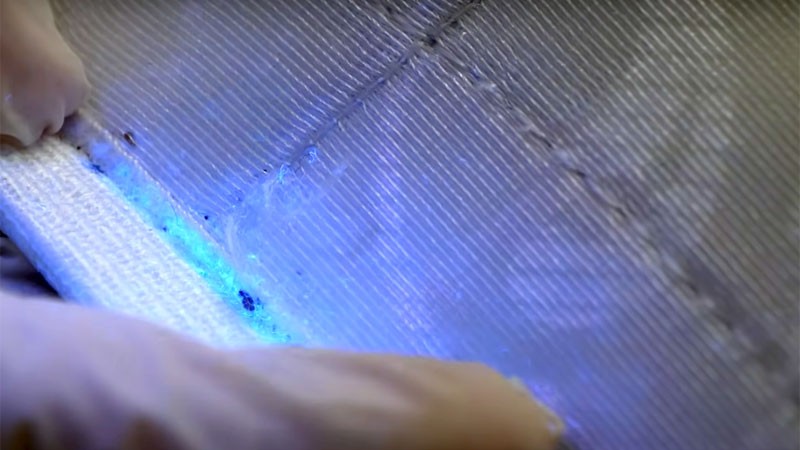Bed bugs are a nightmare whether you sleep in a simple tiny house or an expensive hotel. The threat of contracting bed bugs and their biting is worrisome. Identifying bed bugs is challenging. Most bed bug control methods are unfeasible, expensive, time-consuming, and ineffective. So today, this article assumes a different approach and outlines how you can use UV light against bed bugs.
Table of Contents
What are UV lights?
Ultraviolet (UV) light is electromagnetic radiation with a wavelength spanning from 10 nm to 400 nm. UV light wavelength ranges from 30 PHz to about 750 THz, shorter than visible light but longer than X-rays. Natural sunlight has UV light which makes up about 10% of electromagnetic radiation from the sun. But, some artificial UV light sources include tanning beds, mercury vapor lighting, halogen, fluorescent and incandescent lights, and lasers.
Ultraviolet UV lights fall into three categories; ultraviolet A (UVA), ultraviolet B (UVB), and ultraviolet C (UVC), based on their wavelength. Most UV lights that reach the earth’s surface from the sun are UVA, with only a tiny proportion of UVB. UVCs have the smallest wavelength ranging from 100nm to 279 nm and are entirely absorbed by the atmosphere and the ozone layer.
UV lights are beneficial to the human body since it is a source of vitamin D. However, overexposure may lead to skin burns and premature aging. Extreme exposure to UV lights may lead to skin cancers.
Can UV lights kill bed bugs?
Direct exposure to UV lights kills bed bugs and their eggs. All variants of UV lights are detrimental to bed bugs since it mutates their DNA. A research study sought to determine the impact of UV light exposure on bed bugs and their behavior when subjected to it. The researchers exposed bed bugs, eggs, and the first nymphal instar to UV light for 1, 2, 5, or 10 seconds at a distance of 4 centimeters. Nymphs exposed to UV lights for less than 5 or 10 seconds were released and left to search for a human host. After two weeks, the experiment results were determined by calculating the mortality rate and displayed on the on-dose response curve.
The study results indicated that UV light exposure reduces bed bugs’ survivability and diminishes their ability to search for a host. All three types of UV lights have varied lethal effects on bed bugs depending on their wavelength. UV lights with shorter wavelengths are more destructive to bed bugs than those with longer wavelengths. A scientific report suggests that UVC and UVB lights induce mutagenic and cytotoxic DNA lesions in bed bugs. Also, UVC light irradiation has harmful effects on insects and microorganisms.
Ultraviolet light has more energy than regular visible light, and you use it to exterminate bed bugs by exposure. UVC irradiation effectively controls pests since it is lethal for their DNAs. UVB light irradiation strongly reduces survivorship and egg production, which limits their procreation.
Effectiveness of UV lights in killing bed bugs
UV lights are ineffective compared to other treatments, such as using a washing machine and dryer to eliminate bed bugs. The effectiveness of UV light depends on direct exposure to bed bugs. Since bed bugs are good at hitchhiking, it would be challenging to locate them within your household. More so, bed bugs mostly hide in small cracks and crevices, which would be challenging to expose UV lights directly.
Using UV lights to control bed bugs is ineffective since you will have to expose bed bugs to UV radiation for a long time to attain mortality. As such, you will have to subject UV light on bed bugs for about an hour, which is challenging to achieve since the bed bugs keep moving. Simply exposing bed bugs to UV light for a short time will reduce their survivability and not exterminate them.
UV light is a powerful tool that can illuminate any living organism under low light conditions. However, if you shine bright UV light on bed bugs, it scares them away since they tend to prefer darker conditions. Only the UV light heat can cause severe damage to the bed bugs if exposed to light momentarily.
It is best to use UV light to detect bed bugs and apply other procedures to eliminate them. There are several Do-It-Yourself approaches that you can opt to use. These DIY approaches include vacuuming all contaminated surfaces, electronics, walls, and other hiding locations.
To kill them, you can also treat clothing and bedding by exposing them to heat exceeding 120°F (48° C) to kill them. Even better, you can use steam cleaners that produce extreme heat to kill bed bugs. The steam produced has low moisture vapor and high temperatures, creating a lethal environment for bed bugs. It has a small nylon brush that sweeps the bed bugs’ eggs and nymphs.
Can you detect bed bugs with UV light?
A UV light detects bed bugs more effectively than it kills them. If you shine UV lights at bed bugs, their exoskeletons and eggs glow, making it easier to identify them. So, UV light is perfect for bed bug detection but ineffective at exterminating them.
Natural light and UV light are similar and possess similar characteristics since they are produced by the sun and other artificial sources. However, they work differently does to chemical configuration and wavelengths. The human eye perceives different wavelengths of light in various colors, including red, blue, green, and yellow. The bigger the wavelength a light has, the more visible it is to the naked eye.
If you shine an ultraviolet light, it will appear as a dark purple color. This is the highest form of UV light visible to the human eye. The rest of the UV light will be emitted but will be invisible. However, the UV light will react to any phosphor surface that can absorb and emit light energy. Phosphor materials are luminescent, and their examples include teeth, nails, some special banking note ink, and insects’ shells.
The phosphors in the bed bug’s shell will act as a luminescent. It will attract, absorb and emit UV light energy. If you shine UV light directly on bed bugs, you will be surprised to see the tiny bugs moving while shining bright light back. You should use the UV light to identify where bed bugs are hitchhiking in the house as you determine the best treatment option you should use to exterminate them.
Steps to follow when detecting bed bugs with UV light
• Clean up all the clutter
Start the process by cleaning all the mess in your place. Remove books, accessories, electronics, shoes, and other personal belongings that bed bugs can hide on. Be sure to place them in a plastic bag and treat them efficiently later.
• Seal off any entry and exit points
It would be helpful to seal all entry and exit points to limit the movement of bed bugs. You might want to check the cracks and crevices on the walls and block them. Also, seal off any openings in doors and windows.
• Start checking from your bedroom
Most bed bugs in your house hitchhike within your bedroom. You must scan everything in your bedroom, especially furniture and clothing. Pay close attention to the mattress, bed sheets, and bed frame. Shine the UV light slowly while searching for small glowing and moving bugs. You should shine UV light on any joints, gaps, and holes. Bed bugs hide and lay eggs in such places.
• Remember, Old bed bug shells glow too
It would be imperative for you to understand that old bed bug shells glow too. If you shine a UV flashlight on old exoskeletons, they will glow too. However, this does not affirm that you have bed bugs in your place. Make sure bed bugs are the ones glowing before raising the alarm.
Final thoughts
Many struggle to eradicate bed bugs in their homes since it is challenging. If you have bed bugs in your home, it is best to use tested and proven methods such as heat treatment. This post outlined the effectiveness of UV light against bed bugs, and it is apparent that it is best suited to detect as opposed to exterminating bed bugs.
FAQs
Can UV-A light help you detect bed bugs?
Yes. UV-A light will help you detect bed bugs.
Can UV light kill bed bug eggs?
Yes. Directly exposing adult bed bugs, nymphs, and eggs to UV light will kill them.
Is it safe to use UV light?
Overexposure and a prolonged low dose of UV-C and UV-B rays can harm humans.

